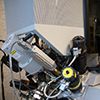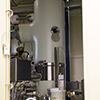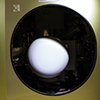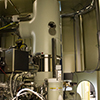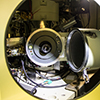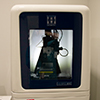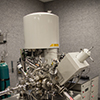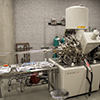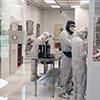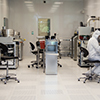You’re accessing archived content
This is archived content from the UIT website. Information may be outdated, and links may no longer function. Please contact stratcomm@it.utah.edu if you have any questions about archived content.
Photos: Utah Nanofab

Ian Harvey, Ph.D.,
Nanofab associate director
The Utah Nanofab, located in the Sorenson Molecular Biotechnology Building, comprises nano-scale imaging and surface analysis as well as a cleanroom thin film deposition and patterning (think: computer chip technology). These facilities bring together researchers, engineers, and scientists with interests in nano-fabrication, materials imaging/characterization, and advanced materials manufacturing for a very broad range of materials.
"The vision for this building was to be a space where researchers from the life sciences and physical sciences disciplines could come together," said Ian Harvey, Ph.D., Nanofab associate director.
Those taking advantage of Nanofab resources complete their work using a variety of highly technical instruments and microscopes - building and looking at things as large as hip joint replacements and as small as a stack of atoms.
"In the focused ion beam technique we're using ions to blast away material," explained Harvey, who likened it to using a sandblaster to remove paint. "But imagine, instead of sand particles, you're using ions - the smallest solid particle we have that we can actually manipulate usefully. The beam becomes a tiny scalpel for precision cuts the size of a red blood cell."
Scientists use this method to view the structure just beneath the surface of a specific material, and materials studied vary across the board - including things like shale from a deep oil well, complex stacks of materials on silicon, and even kidney tissue. Once enough material has been blasted away, the remaining sample can be moved to another microscope for viewing.
"Then you're looking at the sample at the atomic scale. You start looking at individual atoms," said Harvey. "That's pretty cool."
In addition to the teams already working in the Utah Nanofab, other researchers and scientists interested in using the lab facilities can become members of the lab. Harvey explained that this collaboration across disciplines and organizations has been transformational for new ideas and innovation.
"When we communicate better, and work in teams, good things happen," said Harvey. "The basis for creating this facility was to further break out of a silo mentality and support faculty who are working at the boundaries and interfaces between disciplines."
View photos from the Utah Nanofab below:
Node 4
Our monthly newsletter includes news from UIT and other campus/ University of Utah Health IT organizations, features about UIT employees, IT governance news, and various announcements and updates.


